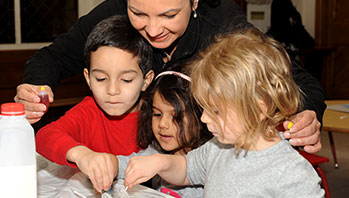- markers
- science notebooks
- sheets of construction paper (one for each child)
- various nonstandard tools for measuring (e.g., small stacking cubes, construction paper cut into strips, paper clips, string, blocks)
- grow
- plant
MA Standards:
Mathematics/Counting and Cardinality/PK.CC.MA.3: Understand the relationships between numerals and quantities up to ten.
English Language Arts/Language/L.PK.MA.1.g: Use vocabulary in the Massachusetts Curriculum Framework for Mathematics pre-kindergarten standards to express concepts related to length, area, weight, capacity, and volume.
MA Draft Standards:
Life Sciences/From Molecules to Organisms: Inheritance and Variation of Traits/LS1/3.D: Recognize stages of the life cycle of plants and animals they have observed and discuss ideas about what happens at each stage. [Patterns, Change]
Life Sciences/From Molecules to Organisms: Inheritance and Variation of Traits/LS1/3.A: Describe/draw and compare the body parts of animals (including themselves) and plants they are investigating [System] and explain functions of some of the observable body parts. [Structure and Function]
Head Start Outcomes:
Science Knowledge/Conceptual Knowledge of Natural and Physical Worlds: Observes, describes, and discusses living things and natural processes.
Science Knowledge/Scientific Skills and Method: Collects, describes, and records information through discussions, drawings, maps, and charts.
PreK Learning Guidelines:
Science and Technology/Life Sciences 10: Observe and identify the characteristics and needs of living things: humans, animals, and plants.
Mathematics/Measurement 14: Use nonstandard units to measure length, weight, and amount of content in familiar objects.
Science and Technology/Inquiry Skills 4: Record observations and share ideas through simple forms of representation such as drawings.
EEC Infant and Toddler Guidelines:
PW44.: The older toddler participates in physical care routines.
Small Groups: Plant Measurements

© Commonwealth of Massachusetts, Department of Early Education and Care (Jennifer Waddell photographer). All rights reserved.
STEM Key Concepts: Plants grow in many places; Plants need water, food, and sunlight to grow; Measure with nonstandard measurement tools; Graph plants to record findings
ELA Focus Skills: Compare and Contrast, Follow Directions, Measuring, Listening and Speaking, Vocabulary
Safety Tips:
- Remind children to wash their hands before and after the activity.
- Remind children not to eat ANY plants or plant parts.
Tell children you want them to choose one of their plants to measure. Explain that they will measure each part of the plant and record the measurements so they can keep a record of how parts of the plant are growing.
- First have children choose a measuring object, such as stacking cubes. Explain to children that they will have to use the same object each time they measure the plant parts.
- Then have children illustrate each part of the plant. Next, help children measure the stem, roots, leaves, and flower.
- Have the children count the cubes with you. Say, My stem is <three> cubes high.
- Help children record the measurements on their illustrations. Be sure to explain that sometimes there will be no growth; sometimes the plant will stay the same.
Explain that each time children measure their plant parts, they need to draw a picture or add changes to the pictures they already drew. Then you will help them record any measurement changes. Say, I will also help you write the name of the day on the bottom of each entry. This will help you see how much your plant has grown each time you check it.
Provide opportunities for children to measure their plants every few days.
Social Emotional Tip: Children learn to approach a task such as measuring with flexibility, inventiveness, and imagination when they are allowed to demonstrate initiative by making independent choices.
Adaptation: Adapt the materials and procedures if younger children will be working in a group. You might prefer to have each young child do the activity individually, with one-to-one supervision.
